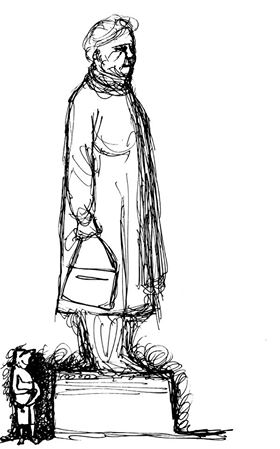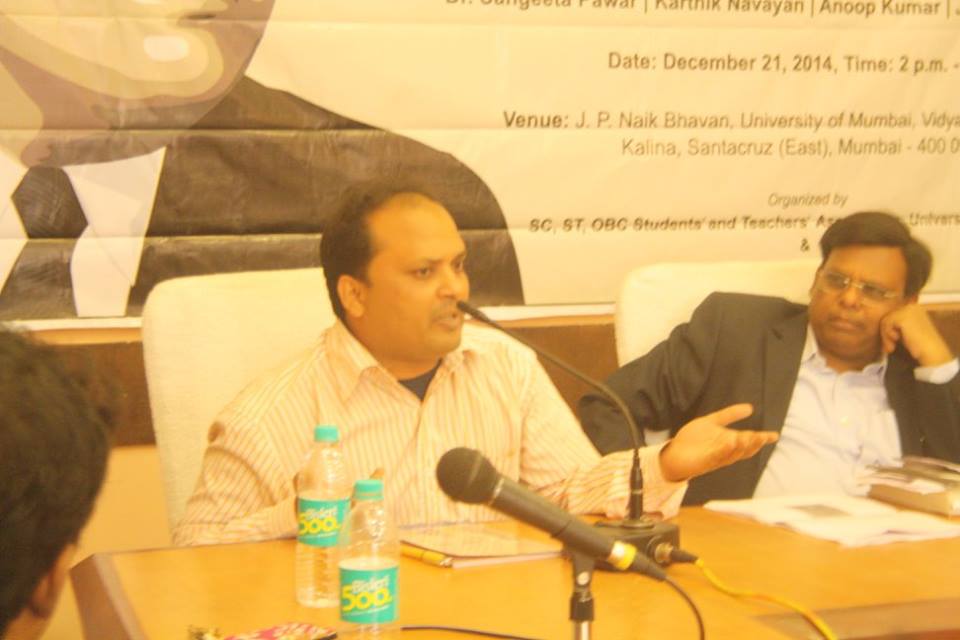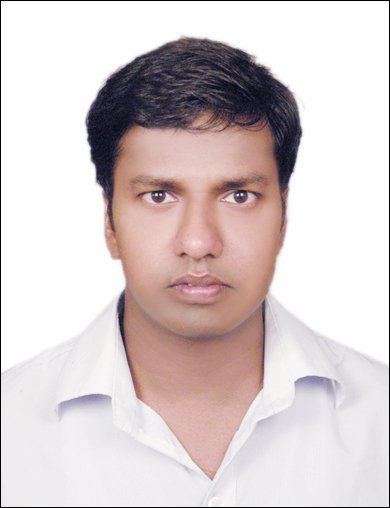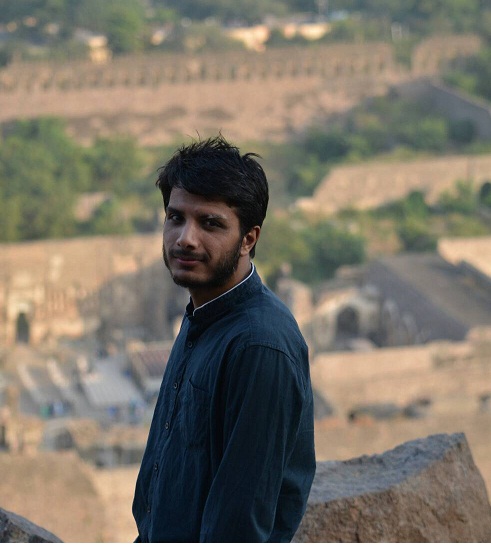Rahul Sonpimple
I was told that I couldn’t rent the bicycle that day. All entries to our basti (slum) were blocked by the police. I was eighteen then. I insisted, but Namdeo, the cycle wala (shop owner), didn’t even bother to look at me and hurriedly shut the shop. With all his ferocity and rage, he just said, “Curfew lagala aahe sarvi kade” (There is curfew everywhere). I was not sure how exactly I was supposed to respond to his rage. But for the first time in my cognitive growing, I associated with the word ‘curfew’, which people around me were mentioning with panic, fear and anger. The elders in the basti perhaps understood the word more deeply with their experience of facing such situations in the past.
 For me though, it was new and terms of distinction such as ‘they’ and ‘we’ made a clear impression in my mind for the first time. I had to make those distinctions; I had no choice. As Ajji (old lady) in the basti would say, “Tynai ammcha lokala marle, jaticha maj aahe tyana” (They killed our people, they are arrogant of their caste). Four members of our community were brutally killed in Khairlanji, a village in our neighboring district Bhandara. It took no time for agitations to start in my city Nagpur as the news of rape and murder of the women of Bhaiyalal Bhotmange’s family traveled like wildfire in Dalit localities in my city. Although I was familiar with the difference between ‘them’ and ‘us’, as upper caste parents from neighboring colonies would ask their children to not play with our boys from our slum, it was only on that day that I too accepted, even affirmed this difference.
For me though, it was new and terms of distinction such as ‘they’ and ‘we’ made a clear impression in my mind for the first time. I had to make those distinctions; I had no choice. As Ajji (old lady) in the basti would say, “Tynai ammcha lokala marle, jaticha maj aahe tyana” (They killed our people, they are arrogant of their caste). Four members of our community were brutally killed in Khairlanji, a village in our neighboring district Bhandara. It took no time for agitations to start in my city Nagpur as the news of rape and murder of the women of Bhaiyalal Bhotmange’s family traveled like wildfire in Dalit localities in my city. Although I was familiar with the difference between ‘them’ and ‘us’, as upper caste parents from neighboring colonies would ask their children to not play with our boys from our slum, it was only on that day that I too accepted, even affirmed this difference.
My choice of identifying differences with upper castes may hurt the liberals, secularists, Marxists and many others to whom I might sound secessionist and as someone who is against the imagined idea of ‘Unity in Diversity’. I choose not to bother about their anxiety until they sufficiently humanize themselves, stop killing us every day and realize that we too are humans and not destined to die in sewer holes every day. So let me make a deliberate attempt and tell the upper castes that yes, we are different as we (Dalits) have always been and still get treated as surplus bodies. Yes, the bodies without souls, as your Dharma Shastras justify ‘your arrogance and our agony’. Now when Dalits are protesting and building movements against caste injustice in various regions of the country, I see uncanny politeness towards us in both their camps.
For rightwing conservative upper castes, if we are no longer untouchables and instead important allies in their ‘Hindu Unity’, then for liberal-secular upper castes, we are perfect welfare subjects and guilt erasers. I am scarcely empathetic to their politeness. I wonder whether they realize that caste is not a Dalit question, it is rather a question of the history of the position and privileges of upper castes. Or they have been caught in a lie – a lie of pretending humanism. In their pretentious attempts they fail to confront that we dream of becoming ‘equal’ citizens. The equal citizenship, which we often hear and discuss, but the epistemic weight of which is rarely felt. Urban upper caste kids might laugh at my proposition; they may until they register themselves on matrimonial websites. They might feel uneasy to see the hollowness of their world and normalize their ironies or they might choose to confront the contradiction – the contradictions of the upper caste world, which Ambedkar habitually made known to Gandhi and to his upper caste followers. “At present I am the most hated man in Hindu India,” said Ambedkar, the one who exposed the intellectual and moral poverty of upper castes in his time. His activism and solutions for annihilation of caste were unapologetically radical for upper caste affability. He was made to feel that ‘he was a snake in their garden’.
I believe he had no faith in them doing good for us. He doubted civility from their side. He even refused Gandhi’s guilt-ridden offering of ‘Harijan’ (children of god) to us. As he was no believer in upper caste progressiveness and saw nothing moral in their socio-religious and cultural system, Ambedkar tried to secure our social life within the ambit of constitutional morality and left us with a dream – the dream of autonomy by converting to Buddhism. The modern Pandits in the universities, who never bothered to discuss his ideas and work, are now telling us how his vision was not enough for our emancipation. Amusingly, they keep changing their position nowadays because after Ambedkar’s death, his followers compelled everyone to feel his presence. Earlier they said that he had failed, and now they say his followers have failed him – this is how their defense mechanism works. Do they ever ask how they have failed to change themselves? Have they and their upper caste world accepted us as equal citizens? I venture to say that they haven’t. Their categories of Harijan, Hindu, proletariat, and we as welfare subjects, helps them in stabilizing their moral order, while these very categories remind us that we are ‘surplus’ for them.
Having grown up in an active socio-political environment in my slum and partaking in various community programs and discussions, I see one persistent aspiration among community activists – an aspiration of becoming the ruling community. When will someone from our community (Dalit) become the prime minster of India? – this is the question with which debates often end in both hope and despair. This question not only brings forth our political aspirations but also drives many of us emotionally. I am no daydreamer though. Given India’s present electoral calculations, one can count electoral impossibilities and show why we can’t have a Dalit PM. Yet, I wonder whether this doesn’t raise a crucial moral question? – the question of justice in the world’s largest democracy. Or else should we just dispense with the integral role of what are now comatose words – democracy and justice – in Mahan Bharat/Great India?
A democracy which is languishing with its horrifying social system of caste, which allows one group to rule another, which provides inconceivable impunity to the upper castes to rape Dalits, murder them, parade them naked, humiliate and reduce them even even lower than animals. Perhaps we Dalits are forced to call this a democracy. And perhaps it is puzzling for upper castes too as their impunity comes under constitutional surveillance in their independent India. Independence, which Pandit Nehru must have experienced – “At the stroke of the midnight hour, when the world sleeps, India will awake to life and freedom,” he said with peace and confidence in his freedom speech. He was happy and hopeful upon freedom from the British, but he was not uneasy for the people who were struggling to get out of the watertight compartments of caste and its humiliation. They were far from the light of fireworks – the light of freedom in Nehru’s upper caste world.
While the Brahmin Prime Minster Nehru saw life and freedom in postcolonial India, an untouchable barrister Ambedkar flashed the contradictions of the upper caste world. “We are going to enter into a life of contradictions,” said Ambedkar in the Constituent Assembly. While Nehru saw nothing moral in giving justice to India’s marginalized on the basis of their caste identity, for Ambedkar caste was the source of marginalization. Nehru wrote against reservation on caste basis. His anxiety was common and shared among other ideological and political camps of upper castes. Now anxiety over reservation for marginalized castes is a part of the upper caste worldview. And they have found an answer to their mental uneasiness by creating stigma around reservation. As students in the university, I see them quite trained in humiliating Dalits and other marginalized castes by using the stigma of reservation. We too know them well now… we no longer feel surprised when we get the news of Dalit and tribal students taking their lives after failing to cope with upper caste stigma.
“Dead bodies speak to you if they don’t die naturally, they trouble those who troubled them’, elders in the basti would say after any unnatural death in the basti, I want to tell them, ‘they are wrong’. Our dead bodies in the universities, in the fields, in the gutter are whispering something very silently to all of us, something about the everyday crisis in our minds, which remains untouched for the upper castes and their moral order. Our dead bodies, they warn us but still place us in a dilemma – a dilemma whether to rebel or to learn to accept the system of rule by upper castes”.
When Shashi Tharoor, an ex-Cabinet minister and known Indian writer, during the Oxford Union debate, asked Britain to pay reparations to India for its 200 years of colonial exploitation, it touched all hearts. Leaders, intellectuals and people from all political and ideological spectrums found Tharoor’s demand moral and perhaps shared the common historical expression in his argument. But has the history of this land ever been common to all? I see nothing common – neither in the past nor in the present. One caste ruling another, upper castes exploiting lower castes over centuries, controlling land, state institutions, education, economy, politics, media, sports, entertainment, and manufacturing the same lie everyday – the lie that we are a nation. Can such realties invoke a common morality? No exploiter and no stratified society can really invoke common human emotions, shared dreams and common moral order between ruled and ruler. In the absence of common morality, how can one think about a common idea of justice?
The oppressed though, are dreamers… they have seen tireless dreams of an equal and just society. Ravidas dreamt it by imagining Begampura, ‘land without sorrow’, Phule through Satyashodhak Samaj (‘Society of Truthseekers’) and Ambedkar left us with the dream of Prabuddha Bharata, ‘Enlightened India’. And Dhasal – The Poet of Underworld – wanted us to explode the society, end all our inner ills and sing songs of man at last. Unsurprisingly upper castes deny, they express disdain, and are everywhere to tell us that our dreams, our paths, are not worthy. One finds them with various identities, looking different, speaking differently, but sounding the same.
For conservative upper castes, our dreams violate Dharma Shastras, for liberals, our acts of rebellion endanger their illusion of unity in diversity, for Marxists, we are victims of false consciousness and for radicals, our struggle is an obstacle in their path of revolution. They have a common fixation – a fixation with ‘primitive ego’, a ‘caste ego’, which cannot tolerate us acting autonomously. Their intolerance can be seen in this general election too. They have diverse but analogous responses on why a Dalit cannot become PM. Let me say it directly, I am talking about Mayawati. A Dalit woman, leader of the lowest of the low and symbol of Dalit assertion in our time –a lone fighter in this heterotopia of the upper caste political world. A leading reason for upper caste anxiety, she is mocked and hated by them – a leader who doesn’t suit theorizations of upper caste-urban university intellectuals – a leader who is not dear to upper caste feminists and yes – a leader who is loved by millions of Dalits and is the Queen of our kingdom.
Born in a chamar family and as a female child, everything was predestined for her. ‘Pair ki jooti pair mein hi rehni chahiya’ (shoes are meant and should remain, only for the feet) – this is the upper caste collective consensus over centuries against Dalits who don’t conform to caste norms. Awarded with a law degree and pursuing her aspiration to become collector, Mayawati had already begun to destroy prearranged caste destiny and violated caste and gender normalcy. Many get punished even for diminutive deviancy from caste. Its order must be respected is everyday culture of India’s upper castes. Every two hours a Dalit is assaulted and at least three Dalit women are raped every 24 hours – India’s National Crime Records Bureau tells us plainly how upper castes maintain their caste supremacy with discipline and punishment. Mayawati was an organic rebel against these caste disciplines.
It was September 1977, at Delhi’s Constitution Club, when she made her first political speech and shook everyone with her fiery critique against Socialist leader Raj Narain for using the word Harijan while referring to Dalits at the three-day conference of the Janata Party. For Kanshiram (Founder of BSP and BAMCEF), she was the perfect leader for carrying out Ambedkar’s dream of becoming the ruling Majority (Bahujan) from a ruled minority. Kanshiram took no time and met Maywawti at her Delhi residence. Having experienced the ruthless hierarchy of caste and gender, and carrying a vision to change the existing order, she decided to drop her aspiration of becoming collector.
It was not easy though. She stood against the hopes of her family and had to depart from customary expectations. With no other choice she left her family house to begin her journey – a journey to change socially assigned role of gender and caste and a journey to transform the victims of caste into rulers of the land. Nevertheless, the decision to join the movement of the most oppressed, become member of an organization which had limited or no resources, an association with icons who had marginal public presence, commitment to an ideology which was already stigmatized by caste elites, and yes vision to become the ruling community, have uniquely shaped her political journey and placed Mayawati as radically different from other leaders of her time. ‘Gav ki kacchi sadko pe aur jhuggi ki tang galiyon me’ (on the unpaved roads of villages and through narrow lanes of slums), she rode her bicycle all over U.P with Kanshiram and BAMCEF members. She had charisma and her speeches would inspire many to join the movement.
Old members of BAMCEF fondly talk about the initials years of her activism in BAMCEF. Mayawati’s ideologically rooted yet colloquial ways of criticizing upper caste led political parties gained significant popularity among Dalits and she became a prominent face of Kanshiram’s new born BSP. After facing defeat three times, Mayawati stepped on the chest of caste-ridden traditions by winning the Lok Sabha seat from Bijnor, UP, with a huge margin in 1989. But this was just the beginning. She had a larger vision – a vision to end caste supremacy of upper castes. With untiring struggle and by challenging caste and gender norms she conquered the throne of Chief Minister of U.P, four times – in 1995, 1997, 2002 and 2007. A state, which was known for its everyday caste practices –– which has highest percentage of Brahmin population and was known for horrifying atrocities against Dalits and women, became a centre of Dalit and anti-caste assertion.
U.P’s everyday culture now started getting color with political tales and stories – yes stories of India’s Dalit leader – and a story of ‘Dalit ki Beti’ (daughter of Dalit community). She became ‘Iron Lady’, standing for victims of caste and an indomitable ruler for caste elites. Post-Ambedkar, the Dalit movement was marked with factions and splits in leadership, and many concluded that the movement had reached its impasse. Such criticisms have fallen flat with the astonishing popularity of Mayawati and expansion of BSP in various other states. She became the tallest and most respected leader of Dalits across the country, and none of her critics can stand before her charisma.
“We should reach there early and secure the front place, so that we can see her,” Vaishali mami echoed in the entire basti, and with her excited yet anxious voice entered my house to check if my mother had got ready. Some were ready and some were still getting ready to attend the BSP’s Dhamma Deeksha Suvarna Mahotsav programme. They must have participated in several such programmes in the past, however, this was unique as their Neta (Leader), their Behenji was coming. ‘Bhim-Shakti Mahila Mandal,’ a women’s group in the basti had decided to go for the programme by marching with slogans and songs of Ambedkar and Mayawati.
It was 2006, lakhs of Dalits were waiting at Indora ground in north Nagpur for their icon while facing off the heat in mid-summer with excitement and eagerness. All the roads coming towards Indora ground were jammed that morning with over packed vehicles. Kamal Chowk, the market area near Indora was occupied with long lines of people rushing towards the programme, blue colored flags were fluttering high in the air, slogans of Jai Bheem and Behenji Zindabad were echoing in the entire market. Hoardings and banners welcoming Mayawati were very well placed at all main spots in the city. A gigantic stage with throne-like wooden chair in the centre, book stalls selling literature on Ambedkar, Kanshiram ,Mayawati and BSP, people struggling to settle down, tight security watching all the sides, buzzing sound of songs in the honor of Mayawati – that day was no less than any festival!
Suddenly people in the ground stood up, their leader had arrived on the stage. Waving back to her leader, an old lady next to me was looking at Mayawati with tears of joy and murmuring ‘Rani aalli re ammchi’ (Our queen has come). Why would Maharashtra’s Dalits hold a leader from U.P in such high regard, my hostel roommate in TISS ( Tata Institute of Social Science Mumbai) inquisitively asked me while I was sharing the memories of this event. I suppose that is what caste has done to us. The complete exclusion in the past and marginal presence in the present. Marginality, which continues with rare presence of our people in the mainstream, occasional remembrance of our icons both by state and society and negligible tangibility of our socio-cultural symbols in public.
Mayawati’s grand and royal presence in the public confronts the upper caste sense of public space, breaks our longstanding marginality and creates a new yet ‘own’ sense of space for Dalits. Her charismatic and larger-than-life presence in the public goes beyond regional and cultural boundaries and connects Dalits emotionally. She is Queen of the ‘Dalit Nation’. However, her presence and devoted acceptance among Dalits creates anxiety and anger among both, so-called progressive and regressive upper castes. Her politics and presence has constantly been judged through Savarna moral gaze. Her blasphemous image stands against the upper caste imagination of nation and nationality. And now in this election, when they are discussing why she can’t lead the nation, I venture to ask them, can their nation accept a Dalit as the Prime Minister?
~~~
Rahul Sonpimple is a research student at JNU and a leader of BAPSA (Birsa Ambedkar Phule Students’ Association).
Illustration by Nidhin Shobhana.










